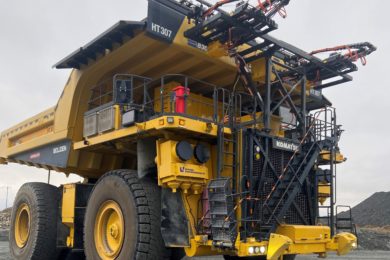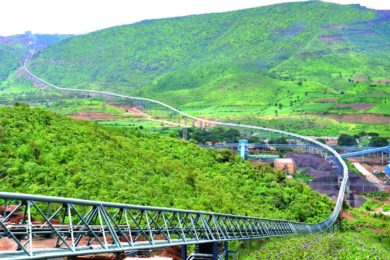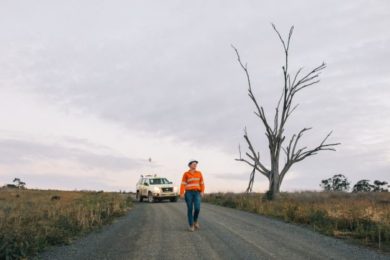An in person meeting at MINExpo 2021 with Wabtec’s Dr Bappa Banerjee, VP Mining; and Rogerio Mendonca, President Freight Equipment offered some fascinating insights into trolley assist technology and the technology side of electrifying mining fleets.
Historically, Wabtec has been working on electric drive systems for mining trucks for many years. In fact as GE Transportation it started that technology with the first commercially viable electric drive system for large mining haul trucks in the early 1960s. Today it includes the optimised integrated AC drives behind everything from the top of the class Komatsu 980E which is seeing a great market response globally especially in Latin America, to the leading Chinese OEM NHL and its largest ever export fleet which covers 28 NTE360A trucks going to Australia’s Yancoal.
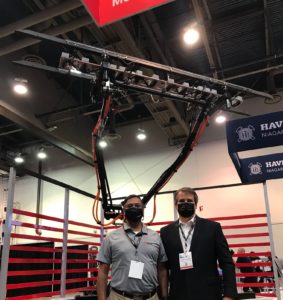
Wabtec’s Dr Bappa Banerjee, VP Mining; and Rogerio Mendonca, President Freight Equipment
Mendonca commented: “So when we have new conversations about electrification of mining, this is right in our core expertise area already. Obviously, the power agnostic technology everyone is looking at has to evolve. But whether you have a diesel engine, battery, fuel cell, pantograph or a combination of these, our energy management system is able to handle all sources of current and convert them into AC driven wheel traction. Our design philosophy is very much power agnostic and our electric systems support that. Today, the wheel traction is electric and the controls are electric.”
He added that Wabtec is also working on electrifying some of the auxiliary systems that remain mechanical. “So when the OEMs decide where they are going in terms of power source, we will be able to handle that in terms of the rest of the truck. And in the future other power sources will also be dealt with by the same logic – with hydrogen the industry is still looking at two options, either burning hydrogen in the combustion engine but this comes with onboard storage issues, and then using a fuel cell as a powerpack. At Wabtec we feel good about the direction in which we are going – our drive system has been electric by design from the very beginning which puts us in the best position to gradually evolve the technology to accommodate new power sources.”
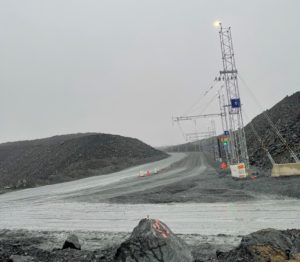 The new trolley line at Boliden Kevitsa
The new trolley line at Boliden Kevitsa
Wabtec’s capabilities when it comes to electric mine haulage also extend to its own mining truck pantograph which was displayed at MINExpo 2021 – the Mining PANTO MTP100. Its pantographs inherit all the depth of experience from acquired company Faiveley, which introduced the single-arm pantograph in 1955 and has been supplying mine operators with pantographs for over 40 years. Wabtec says its mining pantographs “are specially designed for aerodynamics, high traction efficiency, low maintenance and maximum life of wear components.” Dynamic position compensation ensures consistent line contact over the entire working range while adjustable contact force reduces carbon contact wear. Wabtec also services and rebuilds pantographs and offers onsite training. Mendonca added: “The design and construction logic plus the technology of a mining pantograph is very much the same but it has to take into consideration the working environment including vibration and temperature extremes. So it is very robust.”
Banerjee continued: “It is also not an easy task to get the pantograph under the trolley and stay there, so it offers both lateral guidance and also vertical guidance under the overhead line. It is smart enough to know what it is doing. The system guidance also assists the truck operator in helping him or her find the overhead lines.” Will this Wabtec technology then also help to marry trolley with autonomy? Banerjee stated: “The ability the understand the position of the truck and the pantograph relative to the overhead line integrates with the whole control system on the truck. So when we see the first autonomous trolley trucks, they will source information from the same system. It is important to note that a lot of things come together at a mine to make autonomous haulage work but in the specific cases where you will have both autonomy and trolley, our technology will be plug and play with the AHS system.”
On battery with trolley, the talk was also timely given that iron ore miner Roy Hill, in Western Australia, announced while the MINExpo 2021 event was on, the purchase of a Wabtec FLXdrive battery-electric locomotive, which will be the world’s first 100% battery, heavy-haul locomotive for the region and the mining industry. Mendonca said: “In that application it’s a great fit and is real today with a commercial order – the mining truck will get there too.” Roy Hill will receive the newest version of the FLXdrive battery-electric locomotive in 2023 with an energy capacity of 7 MWh. Based on the route and Roy Hill’s rail operations, the FLXdrive is anticipated to reduce the company’s fuel costs and emissions in percentage by double digits per train. The ongoing use of the FLXdrive will also reduce ongoing operational costs through maintenance spend.

Roy Hill has purchased a Wabtec FLXdrive battery-electric locomotive
Mendonca adds: “The ability to draw electric power into a drive system is already here and it can be done in mining today with existing technology. Of course then there is the question of how much battery power you can pack in the truck so that it becomes viable relative to current operations. I think for battery only trucks with fixed charging this is still some way off. But with battery and trolley together it can be done now with the operational success dependent on things like the availability of trolley lines and the types of haulage routes the trucks are running. The truck will run off the trolley but also charge the battery with the battery being used for certain segments such as loading and unloading.”
Banerjee then talked about the wider charging method discussions: “There are four ways to charge a battery today – trolley is just one of them, but Wabtec can offer all four today and are already running today in other industries. Aside from trolley you can charge batteries using wireless charging points and induction technology with a charging pad; then you could use fixed charging but more similar to the heavy duty systems used for ferries that allow for some motion; and lastly of course you have battery swap similar to that being advanced by some of the leading underground mining equipment players.” He pointed out that the industry is still looking at all of these options for surface mining trucks. “Of course there is a certain level of capital investment for trolley lines which is another reason why this is not the only game in town.”
Suffice to say Wabtec considers trolley technology to be a core element of its mining offering and one that is set to see significant growth as mining adjusts to interm and long term emissions reduction targets. Of course it is already a close partner with Komatsu and Cummins and is working seamlessly with them on the 830E-5 trucks introduced with the Trolley Assist Package at Boliden’s Kevitsa nickel-copper mine in Finland and on other trolley conversion projects currently in progress.






